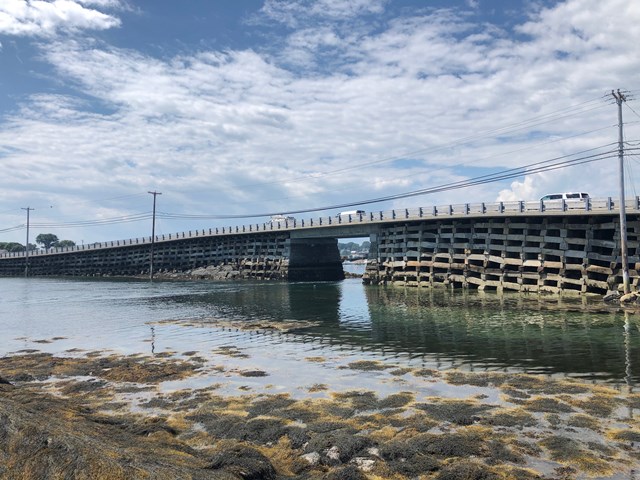We Recommend:
Bach Steel - Experts at historic truss bridge restoration.
BridgeHunter.com Phase 1 is released to the public! - Visit Now
Bailey Island Bridge
Cribstone Bridge

Primary Photographer(s): Cameron Monaghan
Bridge Documented: 2020
Harpswell: Cumberland County, Maine: United States
1926 By Builder/Contractor: Unknown and Engineer/Design: Llewellyn N. Edwards
2010
52.2 Feet (15.9 Meters)
1,167.0 Feet (355.7 Meters)
18 Feet (5.49 Meters)
1 Main Span(s) and 78 Approach Span(s)
2033

View Information About HSR Ratings
Bridge Documentation
Noted for its dry-laid stone substructure, this is reportedly the only known example in the world of a cribstone bridge, specially designed to allow tidal waters to pass through. The main span is a concrete t-beam bridge. The long approach is the portion supported by the stone crib, which is capped off with a concrete slab deck.
View Archived National Bridge Inventory Report - Has Additional Details and Evaluation
View Historic American Engineering Record (HAER) Documentation For This Bridge
HAER Data Pages, PDF
View National Register of Historic Places Nomination Form For This Bridge
View Article About This Bridge
Information and Findings From Maine's Historic Bridge InventoryDiscussion of Bridge Although the main span of the granite crib bridge is a T beam, and it is typed accordingly. It was designed in 1926 by the first state bridge engineer, Llewellyn Edwards. For a long bridge located in a tidal setting, Edwards brilliantly devised a granite crib through which the tide could ebb and flow. The bridge is apparently unique in the United States, but it is reportedly inspired by similar but now non-extant bridges in Scotland. Although certainly something of an experiment, Edwards had well justified reasons for building such an unusual structure, and it had everything to do with location. For all but a narrow channel, the bridge would rest on a rock shelf and never be more than a few feet below water at low tide, but the tide itself had a very strong current. The weight of the granite slabs would be enough to withstand the tide, but the openings between them would allow the tide to flow freely without greatly increasing its velocity. Furthermore, there was an excellent granite quarry nearby. The bridge is considered as Edwards most important work in the state. The bridge has been designated a national ASCE landmark. It is an exceptional preservation priority because it is a unique and successful design by a noted early 20th century bridge engineer. Bridge Considered Historic By Survey: Yes |
![]()
Photo Galleries and Videos: Bailey Island Bridge
Bridge Photo-Documentation
Original / Full Size PhotosA collection of overview and detail photos. This gallery offers photos in the highest available resolution and file size in a touch-friendly popup viewer.
Alternatively, Browse Without Using Viewer
![]()
Bridge Photo-Documentation
Mobile Optimized PhotosA collection of overview and detail photos. This gallery features data-friendly, fast-loading photos in a touch-friendly popup viewer.
Alternatively, Browse Without Using Viewer
![]()
Maps and Links: Bailey Island Bridge
Coordinates (Latitude, Longitude):
Search For Additional Bridge Listings:
Bridgehunter.com: View listed bridges within 0.5 miles (0.8 kilometers) of this bridge.
Bridgehunter.com: View listed bridges within 10 miles (16 kilometers) of this bridge.
Additional Maps:
Google Streetview (If Available)
GeoHack (Additional Links and Coordinates)
Apple Maps (Via DuckDuckGo Search)
Apple Maps (Apple devices only)
Android: Open Location In Your Map or GPS App
Flickr Gallery (Find Nearby Photos)
Wikimedia Commons (Find Nearby Photos)
Directions Via Sygic For Android
Directions Via Sygic For iOS and Android Dolphin Browser
USGS National Map (United States Only)
Historical USGS Topo Maps (United States Only)
Historic Aerials (United States Only)
CalTopo Maps (United States Only)

